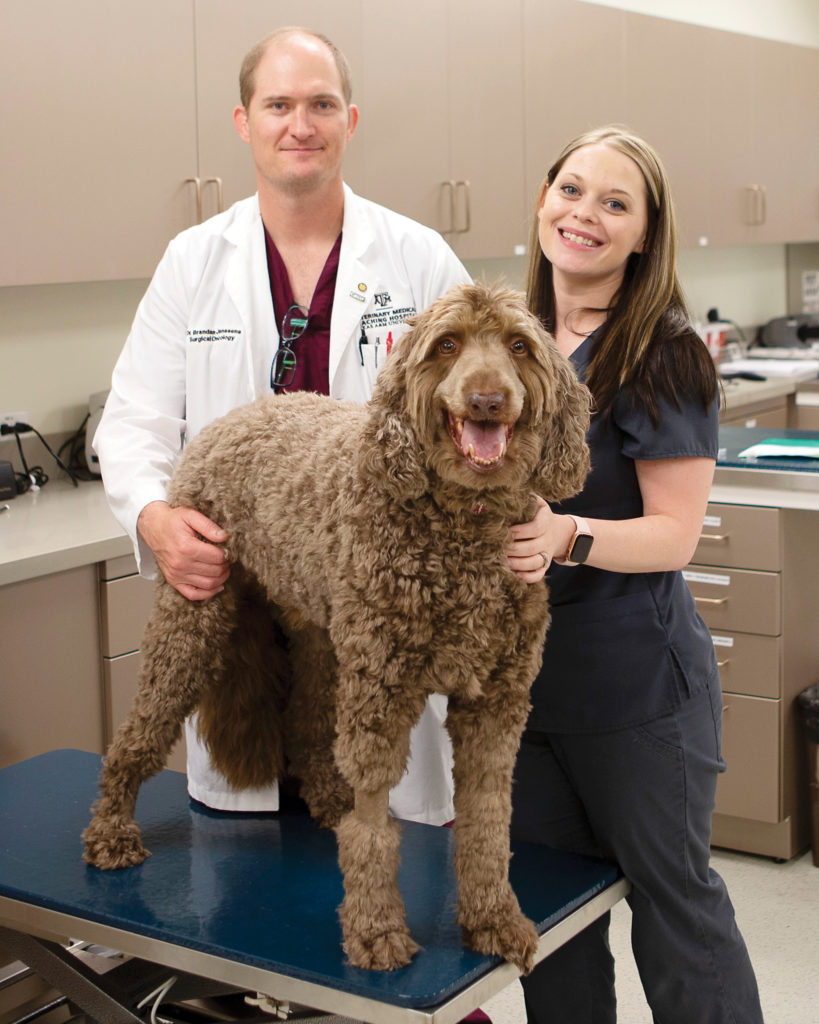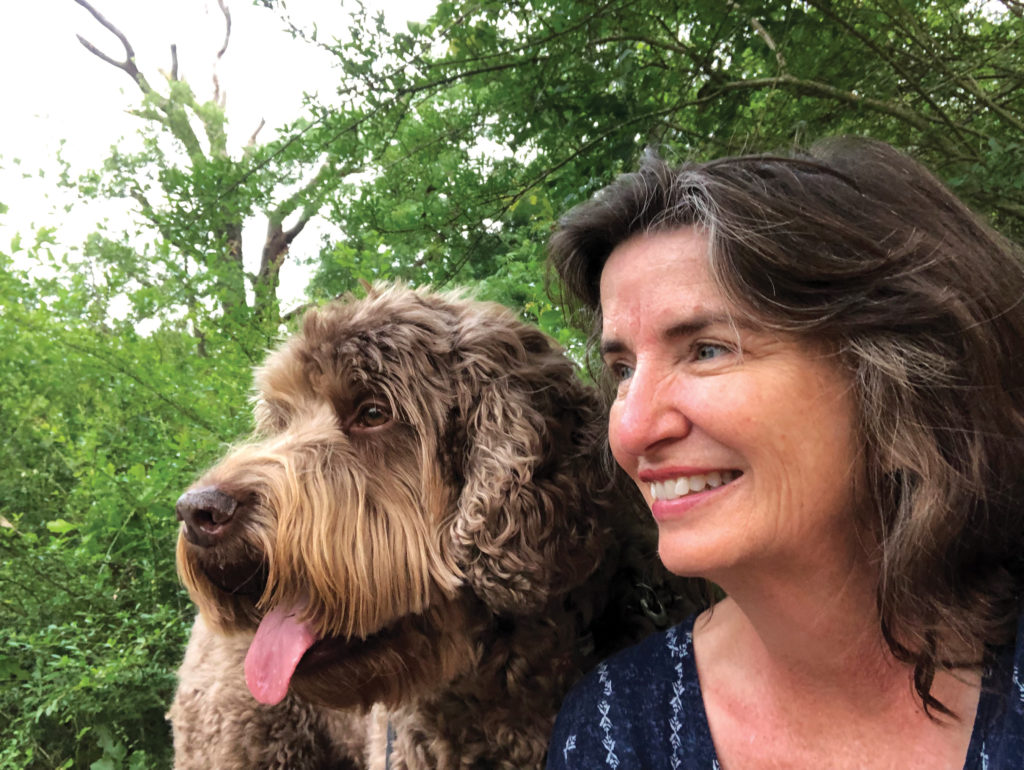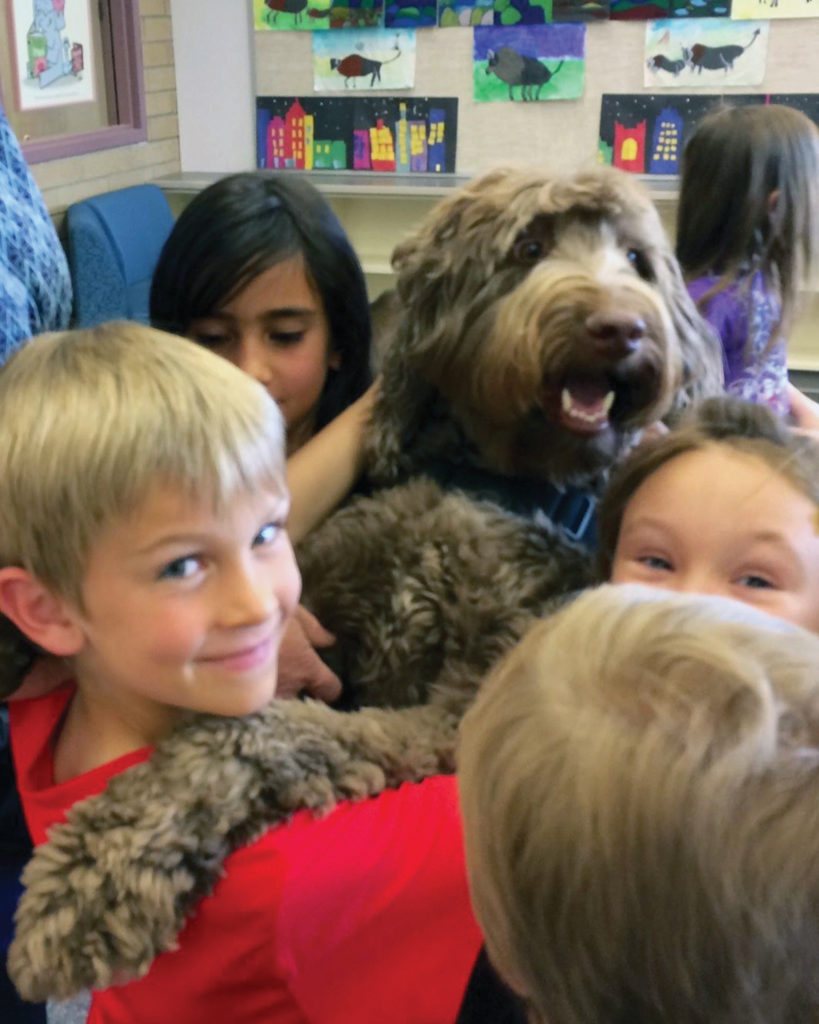The Magic Bullet
Story by Jennifer Gauntt, CVMBS Communications
The Small Animal Hospital treats its share of special patients, but when oncologists treated an 8-year-old Australian Labradoodle named Bullet, they found a dog with its own healing touch.

Like all Aggies, Bullet’s purpose has always been to live a life of selfless service.
When owner Leslie Staven received the now 8-year-old Australian Labradoodle at 8 weeks of age, it was for the purpose of training Bullet to detect for life-threatening peanut allergies.
Little did Staven know then that Bullet would go on to save more people in many more ways than anyone could have ever imagined, and then, in turn, would need the Texas A&M College of Veterinary Medicine & Biomedical Sciences’ (CVM) Small Animal Hospital (SAH) to be saved.
The Nose Knows
Bullet wasn’t intended to spend his life with Staven.
As a specially trained service dog, he had been sent to live with several children afflicted with peanut allergies, but those children weren’t “dog people,” so it never worked out.
But then Staven noticed something about Bullet. While he had been trained to sniff out foods, he was, instead, sniffing out people in need.
She first noticed it when they were around children with autism. Bullet would lead Staven to a child, who would “always assume the same position”—with the child essentially coming nose to nose with Bullet—and they would just stare at each other.
“I’d say something to the child to the effect of, ‘Hey, what’s your name?’ and invariably an adult would come in and say, ‘he doesn’t speak; he has autism,’” Staven said. “I study psychology and have had a lot of experience with people with special needs, so I developed a way to speak through Bullet to the child. What ended up happening was this child who did not speak always answered.
“One child, who had never said anything in his life, reached up, touched Bullet, and said ‘fuzzy,’ at which point the family all just bawled,” Staven said.
In another encounter, Bullet was attracted to a child who only spoke four or five words, primarily to verbalize his own needs. Staven introduced the child to Bullet and said, “‘Bullet wonders if you have a dog.’
“The boy said, ‘No,’ so I responded, ‘That’s cool. Bullet wonders if you have any animals,’” she said. “At this point he said, ‘Yeah, I have a hamster. Its name is Squeak.’ And he went on for 45 minutes, conversing back and forth with the dog. Never looked at me, never looked at the father.”
Children aren’t the only ones touched by Bullet.

On several occasions, both in classrooms and in public, Bullet has detected someone suffering from a post-traumatic stress disorder (PTSD)-related flashback. Each time Bullet has approached, the veteran has wrapped his arms around the dog and Bullet has placed his front legs over the veteran’s shoulders, as if offering a hug. Tears usually fall, and then each veteran tells Staven that “Bullet brought me home.”
Even more incredibly, one day while Staven was taking classes at a university, Bullet began to venture toward a young man.
“The next thing I knew, Bullet was in the boy’s seat, with his legs over the boy’s shoulders and his head on his chest,” Staven said. “I jumped up to apologize, and the boy told me he wanted Bullet to stay. They sat in that position for 20 minutes.
“Weeks later, my professor called me in. She told me she shouldn’t divulge what she was about to tell me, but that boy later came to her. On that morning, he had loaded a gun and planned to kill himself,” Staven said. “For some reason, he decided to go to his first class and if anyone noticed or cared about him, he would go to a mental health clinic. If no one did, he would return to his dorm and kill himself. Bullet saved his life. He said he had never felt so much peace.”
The stories go on and on. Bullet’s Facebook page (I smell trouble – Allergen Alert Dogs) is littered with photos and stories from interactions. As a service dog who travels with Staven, Bullet routinely has these encounters with random people who always need his help.
Luckily, when Bullet needed help, the SAH was there.
Even Heroes Need Saving

In April, Staven was giving Bullet a pill when she saw a little bump on the inside of his mouth. She took Bullet to her veterinarian, an Aggie, who determined that the spot was probably a squamous cell carcinoma.
Staven had worked at the SAH years before, and knowing some of the clinicians, she decided Texas A&M was “the only place I want to go.”
“That’s why I came here, because it’s the best,” she said.
Under the care of Dr. Brandan Wustefeld-Janssens, an assistant professor of surgical oncology, Bullet underwent a procedure to remove pieces of the gum and, because the cancer had grown into the underlying bone, the section of his upper jaw containing his canine and incisor teeth had to be removed, too.
“Bullet’s is a type of cancer that we often see in the mouths of dogs and cats. They’re generally locally invasive and with a complete surgical removal, they can have a good, long-term outcome,” Wustefeld-Janssens said. “Cosmetically, he looks slightly different—his nose droops down a little—but that’s the only change you can notice.”
While Wustefeld-Janssens said the type of cancer Bullet was treated for is quite common, Bullet, himself, is not.
“We see a lot of therapy dogs and emotional support dogs, and we, as a group, feel very strongly about helping them, especially those who help military veterans and those with PTSD,” Wustefeld-Janssens said.
“Bullet’s story, though, is very unusual,” he said. “But dogs are way more intelligent than we are, anyway. There are dogs that are trained to pick up on if your blood glucose level is low; if you’re diabetic, they’ll tell you to eat. It makes sense that he picks up some kind of emotional distress, but there’s no way to explain it.
“He’s obviously very intuitive and picks up cues that we don’t notice, so he is a special dog.”
Changes

When Bullet has had an emotional encounter with someone in need, he is visibly changed for a period of time afterward. Staven has compared what she witnesses with Bullet to the character in “The Green Mile” who absorbs “all the evil.”
“Anytime Bullet’s had a highly emotional encounter, he gets exhausted, completely wiped out,” Staven said. “He changes. But so do the people, in a positive way.”
While Bullet’s recovery time can range from hours to days, Staven believes Bullet remembers long past his recovery.
She recalls when Bullet accompanied her to a gathering of Native American tribes in Montana. Through the crowd, Bullet spotted and approached a very old Native American man in a wheelchair and then suddenly stopped, putting his feet on the arms of the wheelchair. The man began to chant.
“Bullet stood, unwavering, and a small group of people began to circle around us as the man began to touch Bullet’s face in a pattern,” Staven said. “Nose to nose, the man sat and Bullet stood, and then silence. The only English words the man spoke were ‘And so it goes.’ As soon as he uttered these words, Bullet got down, turned around, returned to my feet, and collapsed.”
The man beside Staven told her that the wheelchair-bound man had been waiting for his totem so that he could “go now.”
It took three days for Bullet to return to being himself, but Staven said, even to this day, when Bullet hears music with Native American-style horns and drums, he will howl.
“There isn’t any other music except…,” Staven begins. “OK, we shouldn’t say this because we’re at A&M, but ‘The Eyes of Texas’ comes on the radio at noon everyday (at their home in New Braunfels) after the ‘Star-Spangled Banner’ and when TU’s song comes on, Bullet just barks and howls and sings along. I like to say he’s just hoping for the ‘Aggie War Hymn.’ But that’s the only other time he sings.”
After his experiences at Texas A&M, perhaps that will change.
###
Note: This story originally appeared in the Fall 2019 edition of CVMBS Today.
For more information about the Texas A&M College of Veterinary Medicine & Biomedical Sciences, please visit our website at vetmed.tamu.edu or join us on Facebook, Instagram, and Twitter.
Contact Information: Jennifer Gauntt, Director of CVMBS Communications, Texas A&M College of Veterinary Medicine & Biomedical Sciences; jgauntt@cvm.tamu.edu; 979-862-4216



